AUT - Workplace Communication: Case Study, Skills & Reflection
VerifiedAdded on 2023/06/13
|6
|1920
|143
Report
AI Summary
This report presents a case study analyzing communication challenges within a non-governmental organization, focusing on a specific incident involving miscommunication and its repercussions. It identifies unclear objectives, language barriers, poor leadership, and personal issues as contributing factors to the communication breakdown. The report proposes solutions such as defining organizational objectives, addressing personal conflicts, and providing leadership training. Furthermore, it explores strategies for developing interpersonal communication skills in work-based settings, including adopting an open-door policy, enhancing emotional intelligence, conducting thorough research, managing expectations, and practicing self-evaluation. The author reflects on how these insights will inform their future communication practices, emphasizing the importance of understanding the audience and improving emotional intelligence to foster better workplace relationships and productivity. The document is a student contribution to Desklib, a platform offering study resources.
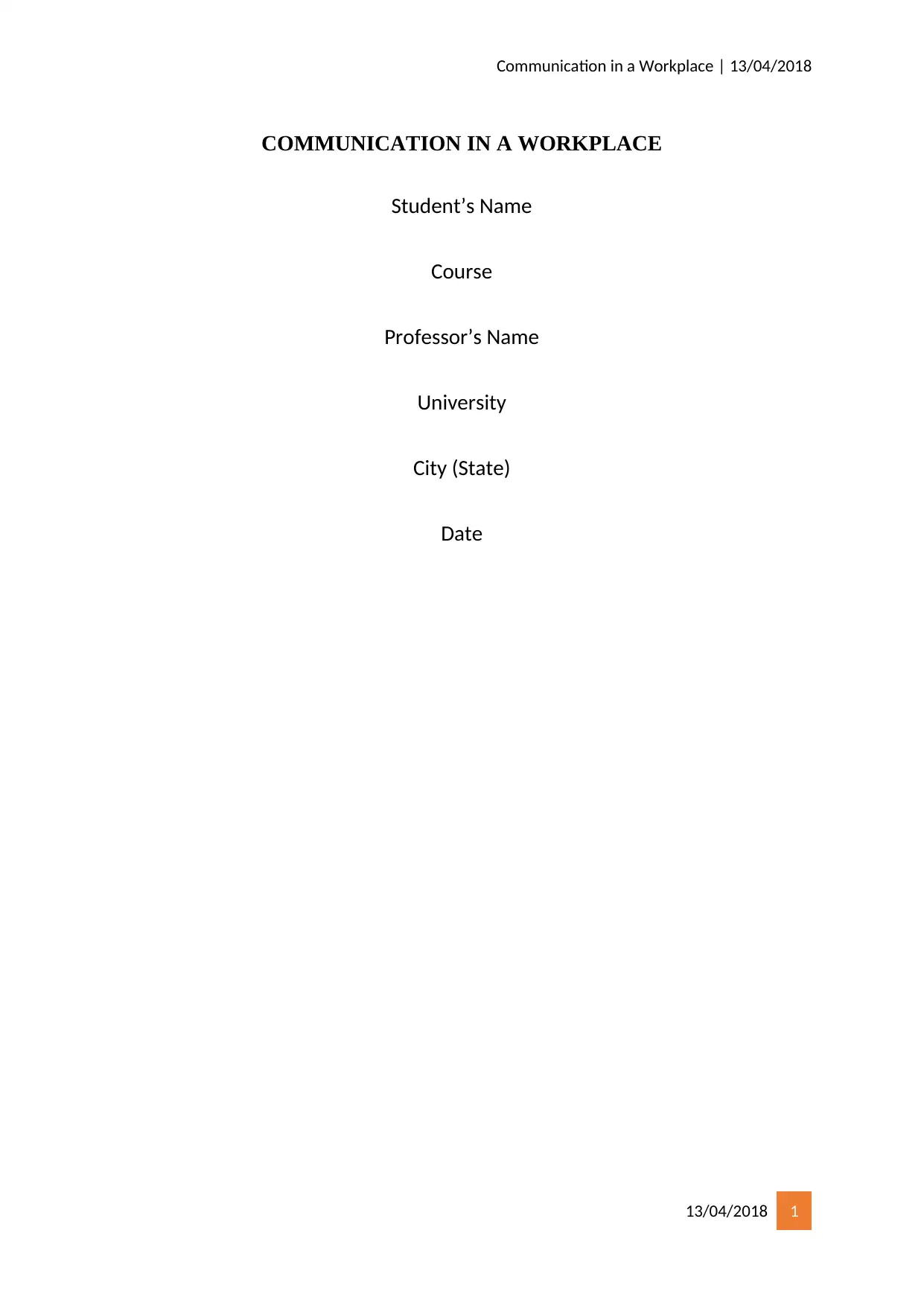
Communication in a Workplace | 13/04/2018
COMMUNICATION IN A WORKPLACE
Student’s Name
Course
Professor’s Name
University
City (State)
Date
13/04/2018 1
COMMUNICATION IN A WORKPLACE
Student’s Name
Course
Professor’s Name
University
City (State)
Date
13/04/2018 1
Paraphrase This Document
Need a fresh take? Get an instant paraphrase of this document with our AI Paraphraser
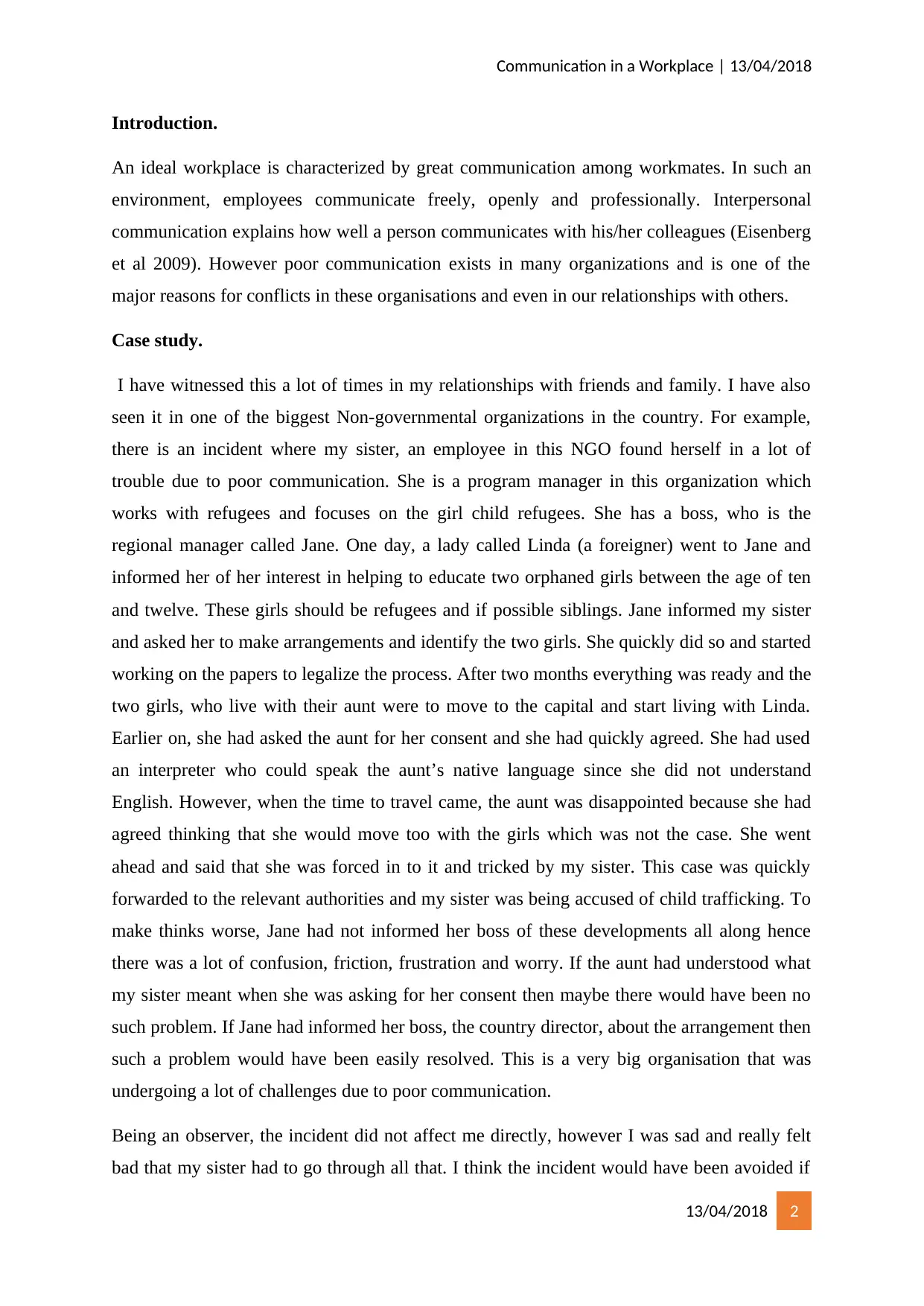
Communication in a Workplace | 13/04/2018
Introduction.
An ideal workplace is characterized by great communication among workmates. In such an
environment, employees communicate freely, openly and professionally. Interpersonal
communication explains how well a person communicates with his/her colleagues (Eisenberg
et al 2009). However poor communication exists in many organizations and is one of the
major reasons for conflicts in these organisations and even in our relationships with others.
Case study.
I have witnessed this a lot of times in my relationships with friends and family. I have also
seen it in one of the biggest Non-governmental organizations in the country. For example,
there is an incident where my sister, an employee in this NGO found herself in a lot of
trouble due to poor communication. She is a program manager in this organization which
works with refugees and focuses on the girl child refugees. She has a boss, who is the
regional manager called Jane. One day, a lady called Linda (a foreigner) went to Jane and
informed her of her interest in helping to educate two orphaned girls between the age of ten
and twelve. These girls should be refugees and if possible siblings. Jane informed my sister
and asked her to make arrangements and identify the two girls. She quickly did so and started
working on the papers to legalize the process. After two months everything was ready and the
two girls, who live with their aunt were to move to the capital and start living with Linda.
Earlier on, she had asked the aunt for her consent and she had quickly agreed. She had used
an interpreter who could speak the aunt’s native language since she did not understand
English. However, when the time to travel came, the aunt was disappointed because she had
agreed thinking that she would move too with the girls which was not the case. She went
ahead and said that she was forced in to it and tricked by my sister. This case was quickly
forwarded to the relevant authorities and my sister was being accused of child trafficking. To
make thinks worse, Jane had not informed her boss of these developments all along hence
there was a lot of confusion, friction, frustration and worry. If the aunt had understood what
my sister meant when she was asking for her consent then maybe there would have been no
such problem. If Jane had informed her boss, the country director, about the arrangement then
such a problem would have been easily resolved. This is a very big organisation that was
undergoing a lot of challenges due to poor communication.
Being an observer, the incident did not affect me directly, however I was sad and really felt
bad that my sister had to go through all that. I think the incident would have been avoided if
13/04/2018 2
Introduction.
An ideal workplace is characterized by great communication among workmates. In such an
environment, employees communicate freely, openly and professionally. Interpersonal
communication explains how well a person communicates with his/her colleagues (Eisenberg
et al 2009). However poor communication exists in many organizations and is one of the
major reasons for conflicts in these organisations and even in our relationships with others.
Case study.
I have witnessed this a lot of times in my relationships with friends and family. I have also
seen it in one of the biggest Non-governmental organizations in the country. For example,
there is an incident where my sister, an employee in this NGO found herself in a lot of
trouble due to poor communication. She is a program manager in this organization which
works with refugees and focuses on the girl child refugees. She has a boss, who is the
regional manager called Jane. One day, a lady called Linda (a foreigner) went to Jane and
informed her of her interest in helping to educate two orphaned girls between the age of ten
and twelve. These girls should be refugees and if possible siblings. Jane informed my sister
and asked her to make arrangements and identify the two girls. She quickly did so and started
working on the papers to legalize the process. After two months everything was ready and the
two girls, who live with their aunt were to move to the capital and start living with Linda.
Earlier on, she had asked the aunt for her consent and she had quickly agreed. She had used
an interpreter who could speak the aunt’s native language since she did not understand
English. However, when the time to travel came, the aunt was disappointed because she had
agreed thinking that she would move too with the girls which was not the case. She went
ahead and said that she was forced in to it and tricked by my sister. This case was quickly
forwarded to the relevant authorities and my sister was being accused of child trafficking. To
make thinks worse, Jane had not informed her boss of these developments all along hence
there was a lot of confusion, friction, frustration and worry. If the aunt had understood what
my sister meant when she was asking for her consent then maybe there would have been no
such problem. If Jane had informed her boss, the country director, about the arrangement then
such a problem would have been easily resolved. This is a very big organisation that was
undergoing a lot of challenges due to poor communication.
Being an observer, the incident did not affect me directly, however I was sad and really felt
bad that my sister had to go through all that. I think the incident would have been avoided if
13/04/2018 2
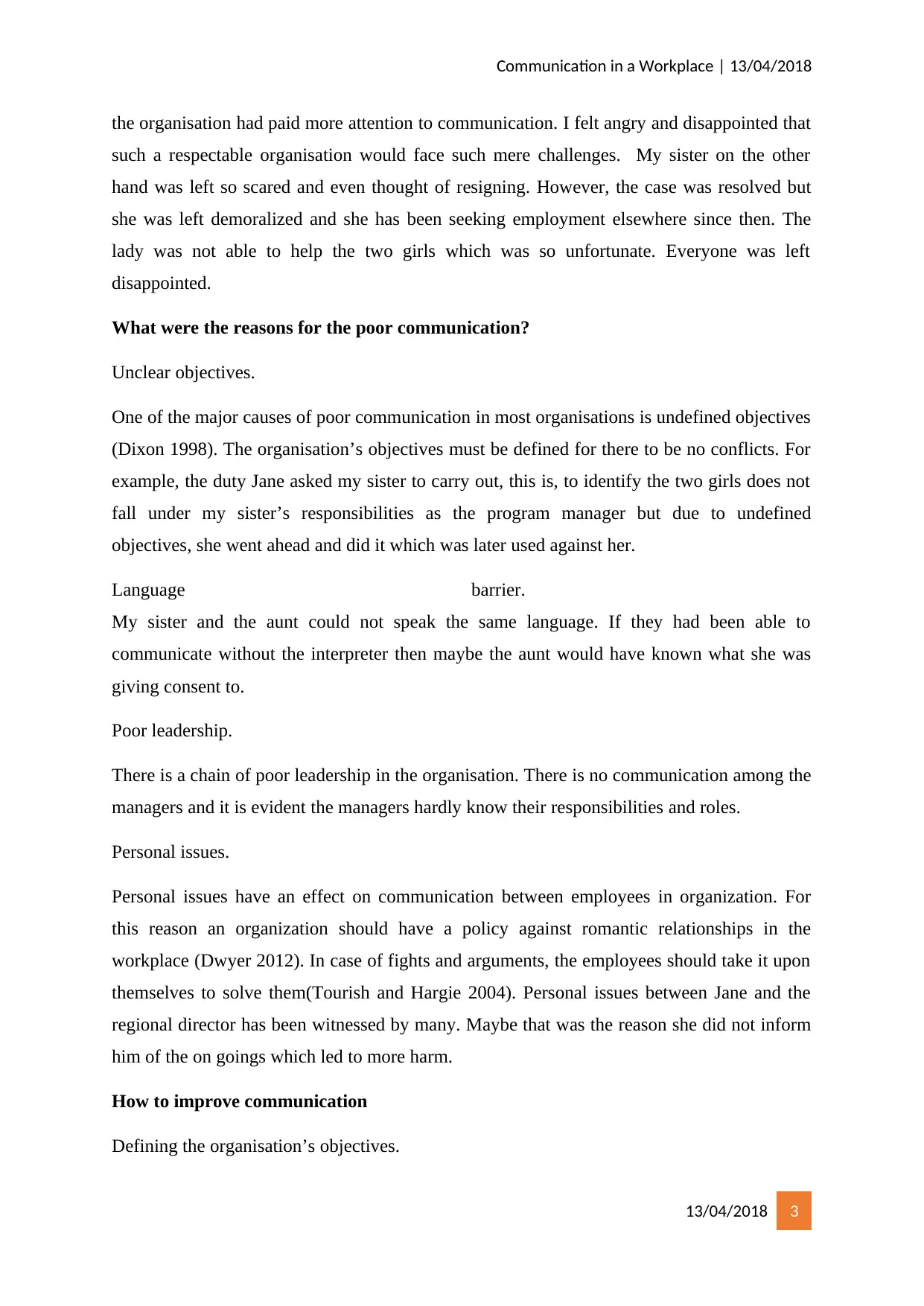
Communication in a Workplace | 13/04/2018
the organisation had paid more attention to communication. I felt angry and disappointed that
such a respectable organisation would face such mere challenges. My sister on the other
hand was left so scared and even thought of resigning. However, the case was resolved but
she was left demoralized and she has been seeking employment elsewhere since then. The
lady was not able to help the two girls which was so unfortunate. Everyone was left
disappointed.
What were the reasons for the poor communication?
Unclear objectives.
One of the major causes of poor communication in most organisations is undefined objectives
(Dixon 1998). The organisation’s objectives must be defined for there to be no conflicts. For
example, the duty Jane asked my sister to carry out, this is, to identify the two girls does not
fall under my sister’s responsibilities as the program manager but due to undefined
objectives, she went ahead and did it which was later used against her.
Language barrier.
My sister and the aunt could not speak the same language. If they had been able to
communicate without the interpreter then maybe the aunt would have known what she was
giving consent to.
Poor leadership.
There is a chain of poor leadership in the organisation. There is no communication among the
managers and it is evident the managers hardly know their responsibilities and roles.
Personal issues.
Personal issues have an effect on communication between employees in organization. For
this reason an organization should have a policy against romantic relationships in the
workplace (Dwyer 2012). In case of fights and arguments, the employees should take it upon
themselves to solve them(Tourish and Hargie 2004). Personal issues between Jane and the
regional director has been witnessed by many. Maybe that was the reason she did not inform
him of the on goings which led to more harm.
How to improve communication
Defining the organisation’s objectives.
13/04/2018 3
the organisation had paid more attention to communication. I felt angry and disappointed that
such a respectable organisation would face such mere challenges. My sister on the other
hand was left so scared and even thought of resigning. However, the case was resolved but
she was left demoralized and she has been seeking employment elsewhere since then. The
lady was not able to help the two girls which was so unfortunate. Everyone was left
disappointed.
What were the reasons for the poor communication?
Unclear objectives.
One of the major causes of poor communication in most organisations is undefined objectives
(Dixon 1998). The organisation’s objectives must be defined for there to be no conflicts. For
example, the duty Jane asked my sister to carry out, this is, to identify the two girls does not
fall under my sister’s responsibilities as the program manager but due to undefined
objectives, she went ahead and did it which was later used against her.
Language barrier.
My sister and the aunt could not speak the same language. If they had been able to
communicate without the interpreter then maybe the aunt would have known what she was
giving consent to.
Poor leadership.
There is a chain of poor leadership in the organisation. There is no communication among the
managers and it is evident the managers hardly know their responsibilities and roles.
Personal issues.
Personal issues have an effect on communication between employees in organization. For
this reason an organization should have a policy against romantic relationships in the
workplace (Dwyer 2012). In case of fights and arguments, the employees should take it upon
themselves to solve them(Tourish and Hargie 2004). Personal issues between Jane and the
regional director has been witnessed by many. Maybe that was the reason she did not inform
him of the on goings which led to more harm.
How to improve communication
Defining the organisation’s objectives.
13/04/2018 3
⊘ This is a preview!⊘
Do you want full access?
Subscribe today to unlock all pages.

Trusted by 1+ million students worldwide
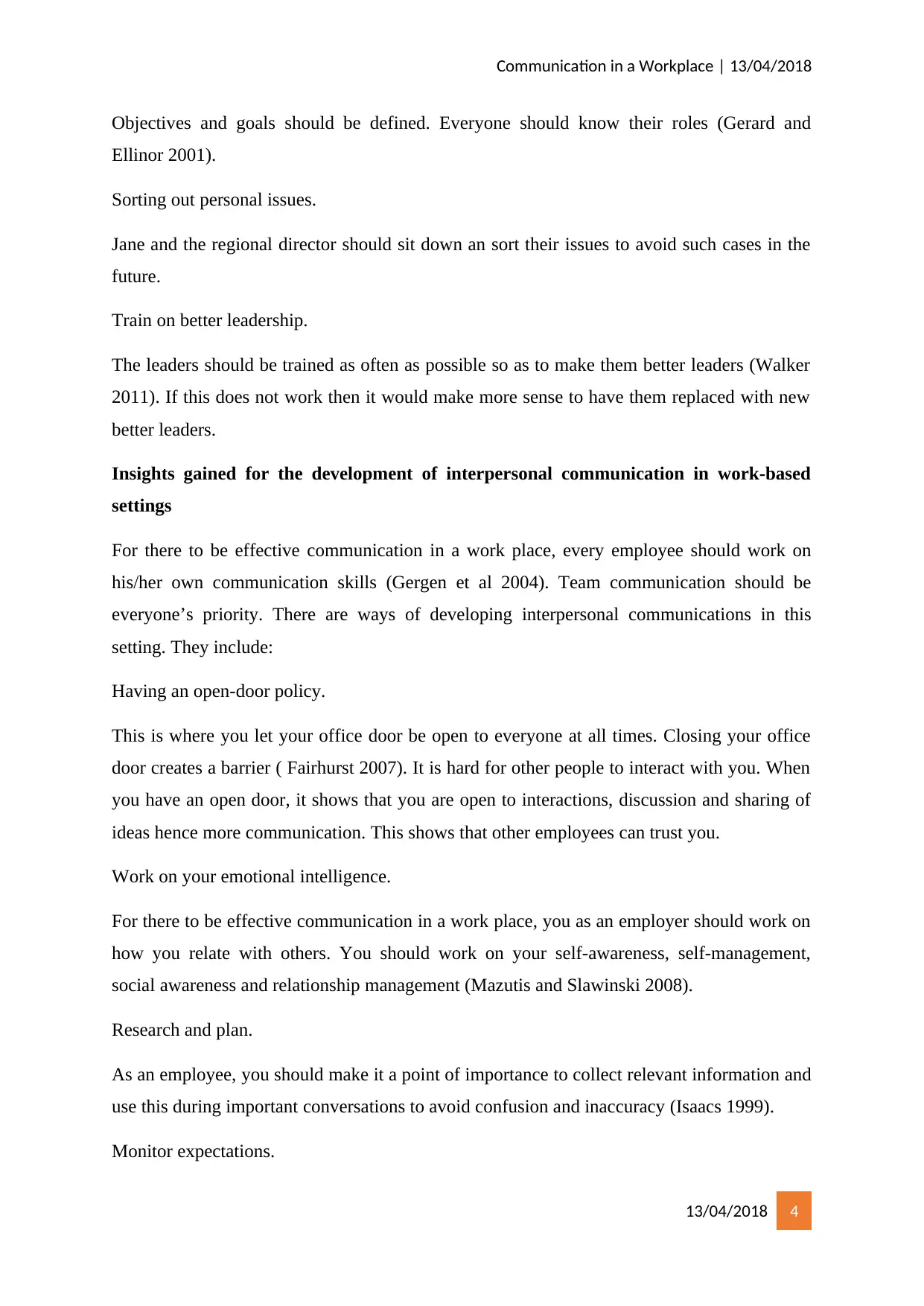
Communication in a Workplace | 13/04/2018
Objectives and goals should be defined. Everyone should know their roles (Gerard and
Ellinor 2001).
Sorting out personal issues.
Jane and the regional director should sit down an sort their issues to avoid such cases in the
future.
Train on better leadership.
The leaders should be trained as often as possible so as to make them better leaders (Walker
2011). If this does not work then it would make more sense to have them replaced with new
better leaders.
Insights gained for the development of interpersonal communication in work-based
settings
For there to be effective communication in a work place, every employee should work on
his/her own communication skills (Gergen et al 2004). Team communication should be
everyone’s priority. There are ways of developing interpersonal communications in this
setting. They include:
Having an open-door policy.
This is where you let your office door be open to everyone at all times. Closing your office
door creates a barrier ( Fairhurst 2007). It is hard for other people to interact with you. When
you have an open door, it shows that you are open to interactions, discussion and sharing of
ideas hence more communication. This shows that other employees can trust you.
Work on your emotional intelligence.
For there to be effective communication in a work place, you as an employer should work on
how you relate with others. You should work on your self-awareness, self-management,
social awareness and relationship management (Mazutis and Slawinski 2008).
Research and plan.
As an employee, you should make it a point of importance to collect relevant information and
use this during important conversations to avoid confusion and inaccuracy (Isaacs 1999).
Monitor expectations.
13/04/2018 4
Objectives and goals should be defined. Everyone should know their roles (Gerard and
Ellinor 2001).
Sorting out personal issues.
Jane and the regional director should sit down an sort their issues to avoid such cases in the
future.
Train on better leadership.
The leaders should be trained as often as possible so as to make them better leaders (Walker
2011). If this does not work then it would make more sense to have them replaced with new
better leaders.
Insights gained for the development of interpersonal communication in work-based
settings
For there to be effective communication in a work place, every employee should work on
his/her own communication skills (Gergen et al 2004). Team communication should be
everyone’s priority. There are ways of developing interpersonal communications in this
setting. They include:
Having an open-door policy.
This is where you let your office door be open to everyone at all times. Closing your office
door creates a barrier ( Fairhurst 2007). It is hard for other people to interact with you. When
you have an open door, it shows that you are open to interactions, discussion and sharing of
ideas hence more communication. This shows that other employees can trust you.
Work on your emotional intelligence.
For there to be effective communication in a work place, you as an employer should work on
how you relate with others. You should work on your self-awareness, self-management,
social awareness and relationship management (Mazutis and Slawinski 2008).
Research and plan.
As an employee, you should make it a point of importance to collect relevant information and
use this during important conversations to avoid confusion and inaccuracy (Isaacs 1999).
Monitor expectations.
13/04/2018 4
Paraphrase This Document
Need a fresh take? Get an instant paraphrase of this document with our AI Paraphraser
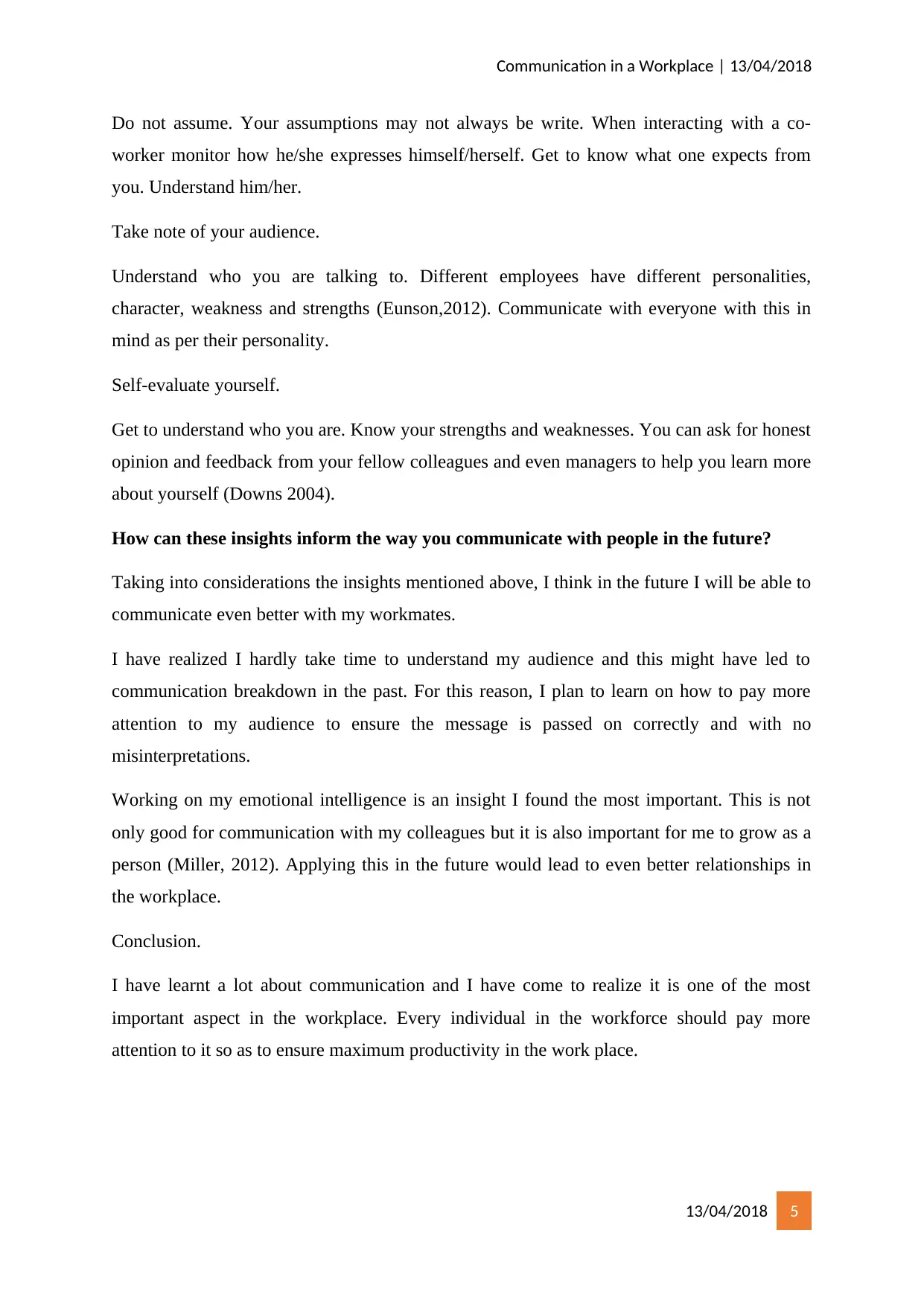
Communication in a Workplace | 13/04/2018
Do not assume. Your assumptions may not always be write. When interacting with a co-
worker monitor how he/she expresses himself/herself. Get to know what one expects from
you. Understand him/her.
Take note of your audience.
Understand who you are talking to. Different employees have different personalities,
character, weakness and strengths (Eunson,2012). Communicate with everyone with this in
mind as per their personality.
Self-evaluate yourself.
Get to understand who you are. Know your strengths and weaknesses. You can ask for honest
opinion and feedback from your fellow colleagues and even managers to help you learn more
about yourself (Downs 2004).
How can these insights inform the way you communicate with people in the future?
Taking into considerations the insights mentioned above, I think in the future I will be able to
communicate even better with my workmates.
I have realized I hardly take time to understand my audience and this might have led to
communication breakdown in the past. For this reason, I plan to learn on how to pay more
attention to my audience to ensure the message is passed on correctly and with no
misinterpretations.
Working on my emotional intelligence is an insight I found the most important. This is not
only good for communication with my colleagues but it is also important for me to grow as a
person (Miller, 2012). Applying this in the future would lead to even better relationships in
the workplace.
Conclusion.
I have learnt a lot about communication and I have come to realize it is one of the most
important aspect in the workplace. Every individual in the workforce should pay more
attention to it so as to ensure maximum productivity in the work place.
13/04/2018 5
Do not assume. Your assumptions may not always be write. When interacting with a co-
worker monitor how he/she expresses himself/herself. Get to know what one expects from
you. Understand him/her.
Take note of your audience.
Understand who you are talking to. Different employees have different personalities,
character, weakness and strengths (Eunson,2012). Communicate with everyone with this in
mind as per their personality.
Self-evaluate yourself.
Get to understand who you are. Know your strengths and weaknesses. You can ask for honest
opinion and feedback from your fellow colleagues and even managers to help you learn more
about yourself (Downs 2004).
How can these insights inform the way you communicate with people in the future?
Taking into considerations the insights mentioned above, I think in the future I will be able to
communicate even better with my workmates.
I have realized I hardly take time to understand my audience and this might have led to
communication breakdown in the past. For this reason, I plan to learn on how to pay more
attention to my audience to ensure the message is passed on correctly and with no
misinterpretations.
Working on my emotional intelligence is an insight I found the most important. This is not
only good for communication with my colleagues but it is also important for me to grow as a
person (Miller, 2012). Applying this in the future would lead to even better relationships in
the workplace.
Conclusion.
I have learnt a lot about communication and I have come to realize it is one of the most
important aspect in the workplace. Every individual in the workforce should pay more
attention to it so as to ensure maximum productivity in the work place.
13/04/2018 5
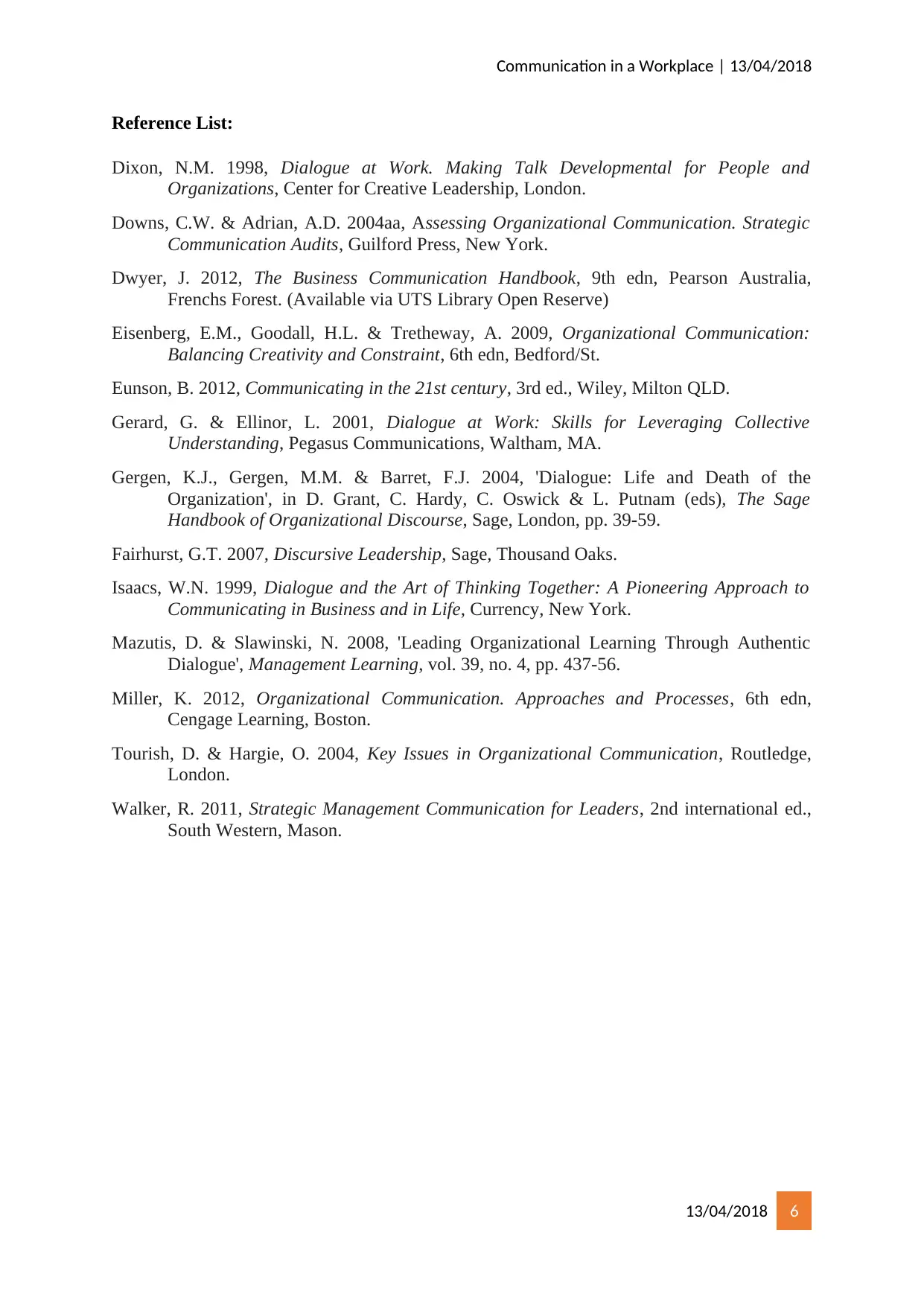
Communication in a Workplace | 13/04/2018
Reference List:
Dixon, N.M. 1998, Dialogue at Work. Making Talk Developmental for People and
Organizations, Center for Creative Leadership, London.
Downs, C.W. & Adrian, A.D. 2004aa, Assessing Organizational Communication. Strategic
Communication Audits, Guilford Press, New York.
Dwyer, J. 2012, The Business Communication Handbook, 9th edn, Pearson Australia,
Frenchs Forest. (Available via UTS Library Open Reserve)
Eisenberg, E.M., Goodall, H.L. & Tretheway, A. 2009, Organizational Communication:
Balancing Creativity and Constraint, 6th edn, Bedford/St.
Eunson, B. 2012, Communicating in the 21st century, 3rd ed., Wiley, Milton QLD.
Gerard, G. & Ellinor, L. 2001, Dialogue at Work: Skills for Leveraging Collective
Understanding, Pegasus Communications, Waltham, MA.
Gergen, K.J., Gergen, M.M. & Barret, F.J. 2004, 'Dialogue: Life and Death of the
Organization', in D. Grant, C. Hardy, C. Oswick & L. Putnam (eds), The Sage
Handbook of Organizational Discourse, Sage, London, pp. 39-59.
Fairhurst, G.T. 2007, Discursive Leadership, Sage, Thousand Oaks.
Isaacs, W.N. 1999, Dialogue and the Art of Thinking Together: A Pioneering Approach to
Communicating in Business and in Life, Currency, New York.
Mazutis, D. & Slawinski, N. 2008, 'Leading Organizational Learning Through Authentic
Dialogue', Management Learning, vol. 39, no. 4, pp. 437-56.
Miller, K. 2012, Organizational Communication. Approaches and Processes, 6th edn,
Cengage Learning, Boston.
Tourish, D. & Hargie, O. 2004, Key Issues in Organizational Communication, Routledge,
London.
Walker, R. 2011, Strategic Management Communication for Leaders, 2nd international ed.,
South Western, Mason.
13/04/2018 6
Reference List:
Dixon, N.M. 1998, Dialogue at Work. Making Talk Developmental for People and
Organizations, Center for Creative Leadership, London.
Downs, C.W. & Adrian, A.D. 2004aa, Assessing Organizational Communication. Strategic
Communication Audits, Guilford Press, New York.
Dwyer, J. 2012, The Business Communication Handbook, 9th edn, Pearson Australia,
Frenchs Forest. (Available via UTS Library Open Reserve)
Eisenberg, E.M., Goodall, H.L. & Tretheway, A. 2009, Organizational Communication:
Balancing Creativity and Constraint, 6th edn, Bedford/St.
Eunson, B. 2012, Communicating in the 21st century, 3rd ed., Wiley, Milton QLD.
Gerard, G. & Ellinor, L. 2001, Dialogue at Work: Skills for Leveraging Collective
Understanding, Pegasus Communications, Waltham, MA.
Gergen, K.J., Gergen, M.M. & Barret, F.J. 2004, 'Dialogue: Life and Death of the
Organization', in D. Grant, C. Hardy, C. Oswick & L. Putnam (eds), The Sage
Handbook of Organizational Discourse, Sage, London, pp. 39-59.
Fairhurst, G.T. 2007, Discursive Leadership, Sage, Thousand Oaks.
Isaacs, W.N. 1999, Dialogue and the Art of Thinking Together: A Pioneering Approach to
Communicating in Business and in Life, Currency, New York.
Mazutis, D. & Slawinski, N. 2008, 'Leading Organizational Learning Through Authentic
Dialogue', Management Learning, vol. 39, no. 4, pp. 437-56.
Miller, K. 2012, Organizational Communication. Approaches and Processes, 6th edn,
Cengage Learning, Boston.
Tourish, D. & Hargie, O. 2004, Key Issues in Organizational Communication, Routledge,
London.
Walker, R. 2011, Strategic Management Communication for Leaders, 2nd international ed.,
South Western, Mason.
13/04/2018 6
⊘ This is a preview!⊘
Do you want full access?
Subscribe today to unlock all pages.

Trusted by 1+ million students worldwide
1 out of 6
Related Documents
Your All-in-One AI-Powered Toolkit for Academic Success.
+13062052269
info@desklib.com
Available 24*7 on WhatsApp / Email
![[object Object]](/_next/static/media/star-bottom.7253800d.svg)
Unlock your academic potential
Copyright © 2020–2025 A2Z Services. All Rights Reserved. Developed and managed by ZUCOL.



